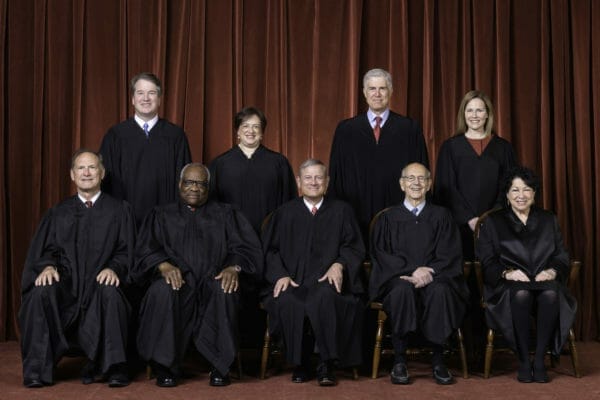
Seated from left to right: Justices Samuel A. Alito, Jr. and Clarence Thomas, Chief Justice John G. Roberts, Jr., and Justices Stephen G. Breyer and Sonia Sotomayor
Standing from left to right: Justices Brett M. Kavanaugh, Elena Kagan, Neil M. Gorsuch, and Amy Coney Barrett.
(Photograph by Fred Schilling, Collection of the Supreme Court of the United States)
U.S.A. –-(AmmoLand.com)- The Supreme Court of the United States has set Wednesday, Nov. 3 as the date it will hear the long-awaited case of New York State Rifle & Pistol Association v. Bruen, which challenges the Empire State’s “good cause” requirement for anyone seeking a license to carry a firearm outside the home for personal protection.
The case was originally called New York State Rifle & Pistol Association v. Corlett, and many people continue to call it that today.
This could be the landmark case of the decade, as the court—with a perceived conservative, pro-Second Amendment majority of 6-3 (or 5-4, depending upon one’s perspective)—could determine once and for all the parameters of the right to bear arms.
As noted by Pete Williams at MSNBC, the high court has already ruled (in District of Columbia v. Heller in 2008) that individual citizens have the right to keep firearms in their own home. But over the past decade-plus, the court has been reluctant to take another Second Amendment case.
The stakes are high, with amicus briefs having poured in from both sides.
Weighing in recently at The Hill on the importance of this case, attorney and Second Amendment scholar Stephen Halbrook quoted soon-to-be-ex-Gov. Andrew Cuomo, who declared, “The streets of New York are not the O.K. Corral and the NRA’s dream of a society where everyone is terrified of each other and armed to the teeth is abhorrent to our values.”
His ability to discuss values notwithstanding, Cuomo didn’t pay much attention to history, as detailed by Halbrook.
“The murder rate in today’s New York City far exceeds that of any cattle town in the Wild West,” Halbrook, who is also something of a historian, wrote. “In 2021, shootings are up almost 70 percent over 2020. Compared to 2019, murders are up nearly 50 percent. People are concerned for their safety. New York is not alone, violent crime in urban areas is surging nationwide.”
New York is one of only eight states that still maintain a “may issue” scheme for handing out carry permits, and frequently authorities find an excuse to not hand them out. Other states have adopted “shall issue” statutes, and nearly half of the states now have what is generically called “Constitutional carry” laws, which means people may legally carry with no permit at all. Many grassroots gun rights activists insist the Second Amendment is all the permit they need.
The situation in New York is exacerbated by the high fees charged to applicants, with no guarantee they will be granted a permit. It takes months, and hundreds of dollars, and no small inconvenience to go through the process. It is a process that seems more designed to discourage people from applying than it is to enable them to be armed in public for their own protection.
Halbrook sums it up nicely observing, “Whether ‘the people’ have a right to bear arms, or whether ‘the people’ is a code term for a government-approved elite, is going to be a challenging argument for New York. Must citizens convince government bureaucrats they have a special need for self-defense? What is it? Ability to pay fees? Connections? Celebrity? Is living in a high crime neighborhood not a special need?”
The key issue is that this case is about a constitutionally enumerated fundamental right, not a government-regulated privilege. Since when, say gun rights proponents, is it necessary to demonstrate any kind of need, or provide any reason whatsoever, to exercise a right?
The gun prohibition lobby is nervous about this case for good reason. If the high court rules against New York, it will have an immediate impact on seven other states, including neighboring New Jersey, Maryland, Massachusetts and California, for example. There are no accurate estimates on the number of people in those and a handful of other states who would immediately apply for licenses or permits to carry, but with somewhere north of 19.5 million citizens already legally carrying with a wallet document, plus an untold number of people packing without a permit/license, is would be safe to presume the numbers would spike upwards fast.
Writing at SCOTUSblog, Amy Howe explains, “The court did not indicate whether it would hear oral argument by telephone, as it has done since May 2020 because of the COVID-19 pandemic, or whether it would instead return to the courtroom for in-person arguments.”
NYSR&PA v. Bruen is one of nine cases the court will hear over a six-day period, she noted. Howe calls this “one of the highest-profile cases of the term so far.”
That being the case, nobody should expect a ruling until the end of the term, in June 2022. Traditionally, the Supreme Court holds its most controversial rulings until the final days of the term, as it did with the Heller case and its ruling in McDonald v. City of Chicago in June 2010.
If the court holds to this tradition, the New York ruling will undoubtedly become a mid-term campaign issue, with Democrats having already proposed restrictive legislation, and passed some in the House. The outcome of the mid-terms may determine whether Democrats and Joe Biden will be finished with gun control next fall, or be given the green light to push whatever legislation they can.
About Dave Workman
Dave Workman is a senior editor at TheGunMag.com and Liberty Park Press, author of multiple books on the Right to Keep & Bear Arms, and formerly an NRA-certified firearms instructor.

The post SCOTUS to Hear New York Gun Rights Case Nov. 3 appeared first on AmmoLand.com.
from https://ift.tt/3gcJcDN
via IFTTT

No comments:
Post a Comment